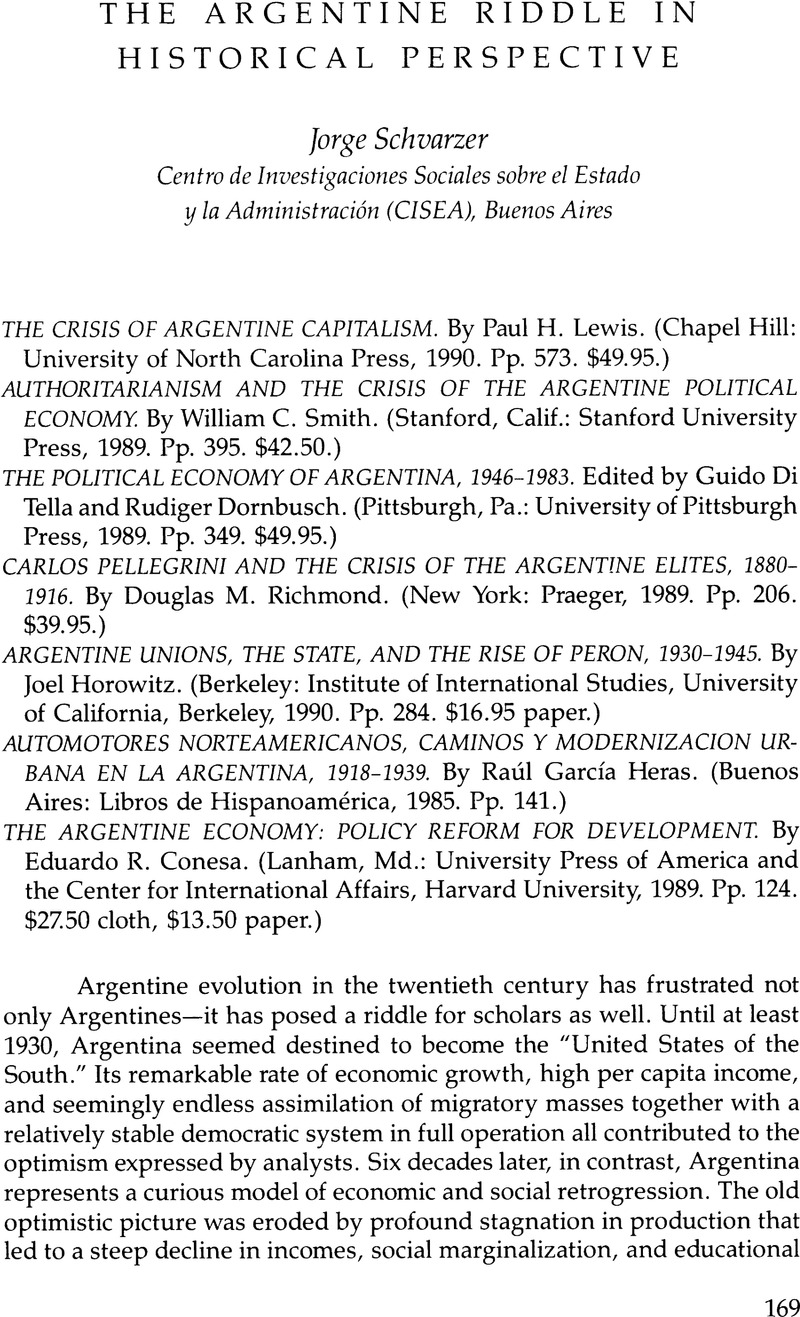Published online by Cambridge University Press: 12 October 2022

1. Felix J. Weil was one of the first observers to warn about the problems created by the “injudicious use of statistics” in Argentine society. His pioneering, but almost forgotten, work sought to correct mistakes in using economic and social data as well as the inclination to resort to questionable estimations when data were not available. Both these tendencies continue to create havoc in Argentine analyses. See Weil, Argentine Riddle (New York: John Day, 1944).
2. Carlos Díaz Alejandro, Essays on the Economic History of the Argentine Republic (New Haven, Conn.: Yale University Press, 1970).
3. For an overall survey, see Jorge Sábato, La clase dominante en la Argentina moderna: formación y características (Buenos Aires: CISEA-GEL, 1988). See also Jorge Schvarzer, Bunge y Born: crecimiento y diversificación de un grupo económico (Buenos Aires: CISEA-GEL, 1989), which deals with the lack of convergence observed between the expansion of a business group and national development.
4. See ECLA, El desarrollo económico de la Argentina (Mexico City: ECLA, 1959); also reference books like Guido Di Tella and Manuel Zymelman, Los ciclos económicos argentinos (Buenos Aires: Paidós, 1973). Curiously enough, these data are not mentioned by Lewis.
5. CISEA studies and surveys of business corporations make it possible to suggest that the elite in question who manage the great traditional firms actually directed those entities and played a relevant role in the political arena throughout the whole period since 1955. This view supplements the observations made by Lewis, although he apparently maintains an opposite interpretation. See a summary of the works mentioned in Jorge Schvarzer, “Corporaciones empresarias y poder político en la Argentina: un enfoque desde adentro,” CISEA mimeo, Buenos Aires, 1990.
6. Lewis makes several unsupported assertions that do not conform with the information available. He states that the military forced Martínez de Hoz to nationalize the Italo (the Compañía Italo Argentina de Electricidad), a private light and power firm (p. 456), even though the inquiries made by a special congressional commission found the former minister guilty of pressing for that very outcome. See Informe El Caso Italo (Buenos Aires: Congreso Nacional, 1985). Lewis also claims that Dante Caputo, a former cabinet minister under Raúl Alfonsín, had leftist sympathies and took up self-exile in Paris (p. 482). Caputo actually remained in Buenos Aires throughout the period of military government. Finally, Lewis states that Alfonsín (whom he regards as pro-left) won the elections thanks to the rightist vote. These notions regarding Caputo and Alfonsin were elements of political debate in 1984 but can now be taken only as personal opinions.
7. See the already classic work of Guillermo O'Donnell, El estado burocrático autoritario, 1966–73 (Buenos Aires: Belgrano, 1982).
8. The nationalization of the railways and its relationship to either a nationalistic or a pro-British stance have given rise to a myriad of contradictory works in Argentina. Perón's early inclination to attract foreign (especially U.S.) capital to oil-related activities was practically ignored until publication of Robert A. Potash's The Army and Politics in Argentina, 1945–1962 (Palo Alto, Calif.: Stanford University, 1980). This work presented a remarkable series of documents on the subject for the years 1946–1948. The practical results in this regard were certainly rather meager due to the pressure exerted by other local interests. Perhaps that is the reason that the question was not brought up by Carl Solberg, who repeats the traditional view of presumed Peronist nationalism on oil until the volte-face in 1954. See Solberg, Oil and Nationalism in Argentina (Palo Alto, Calif.: Stanford University, 1979).
9. Guido Di Tella, Perón-Perón, 1973–76 (Buenos Aires: Sudamericana, 1982).
10. Larry Sjaastad, “La reforma arancelaria argentina: implicaciones y consecuencias,” mimeo for the Centro de Estudios Macroeconómicos Argentinos (CEMA), 1981; and Sjaastad and Carlos A. Rodríguez, “Políticas de estabilización en la economía argentina, 1977–1982,” CEMA mimeo, 1982.